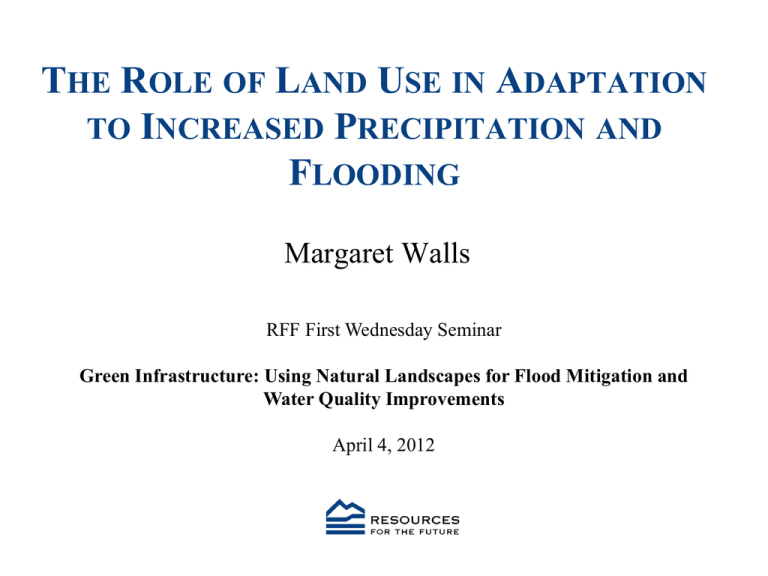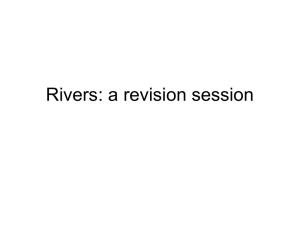T R L
advertisement

THE ROLE OF LAND USE IN ADAPTATION TO INCREASED PRECIPITATION AND FLOODING Margaret Walls RFF First Wednesday Seminar Green Infrastructure: Using Natural Landscapes for Flood Mitigation and Water Quality Improvements April 4, 2012 Background 2011 study by RFF researchers on how natural landscapes can help build resilience to climate change – in particular, the increased flooding associated with more extreme events Co-authors: Carolyn Kousky, Sheila Olmstead, Molly Macauley, Adam Stern • Case study: East River Watershed, near city of Green Bay, in Wisconsin’s Lower Fox River Basin • Funding from Great Lakes Restoration Initiative via NOAA Coastal Services Center Digital Coast Partnership April 2012 Study Area East River Watershed (89,600 acres) April 2012 Climate Change, Extreme Events, and Flooding Climate modeling for Great Lakes region and for Wisconsin: By mid-century… Temps 2.0-4.0° C higher than 1960-90 reference period Spring precipitation 15-25% higher (under high emissions scenario) Extreme events, Green Bay: • 12% increase in 100-year, 24-hour precipitation events • Heavy events – greater than 3 inches – see biggest increase Historical trends support the modeling Some serious flood events in recent years in the region Major water quality concerns April 2012 Land Use in the East River Watershed City of Green Bay 60% of land in ag Forecast: 46% increase in developed land use by 2025 100-Year Floodplain in the ERW April 2012 Scenes from the East River Watershed April 2012 Evaluating a Green Infrastructure Investment If land projected to be developed by 2025 is preserved instead what are the flood protection benefits? what are the costs? Flood protection benefits: Our Focus Reduce exposure – if less development, lower economic losses in a flood event Change hydrology – less impervious surface, lower peak discharge and lower flood heights Costs – land or easement purchase cost April 2012 The Hazus Model GIS-based FEMA model that estimates damages from flood events Digital elevation model (DEM) is input for delineation of stream network Hydrology/hydraulics model generates flood surface elevation layer, which gives flood depth for given return periods (e.g., 100-yr flood) Inventory of structures at Census block level & depthdamage curves yield damages from flood events User can do a Level 1, 2, or 3 analysis o We do Level 2 – some user-supplied data (including finer resolution DEM; parcel-level property info) April 2012 How We Use Hazus Estimate losses in future 2025 scenario with development as projected by county, for different flood events Estimate losses in alternative 2025 scenario with no development in floodplain Compute average annualized losses for each scenario ------------------------------------------------------------------------------------------------------------------------------- Difference = an estimate of annual benefits from preserving land from development April 2012 Estimated Benefits and Costs Average Annualized Loss Current Land Use (2010) Future Land Use (2025) $19.43 million $22.06 million Benefits $2.63 million 833 parcels, 7,403 acres Annualized Costs: • Fee simple purchase… $5.1 million • Easements… approx. $3.1 million About 1/3 of the land projected to be developed Benefits < Costs April 2012 Targeting Three scenarios for targeting green infrastructure investments 1. Flood depth – only parcels > 1 ft mean flood depth in 100-yr flood 2. Flood depth & parcel size – only parcels that account for 90% of total acre-feet of flooding 3. Flood depth, parcel size, and costs – only parcels below median cost per acre-ft of flooding (property value as measure of cost) April 2012 Costs Under Alternative Scenarios Scenario 1: Scenario 2: targeting based targeting based on on flood depth flood depth and parcel acreage Scenario 3: targeting based on costs, flood depth, and parcel acreage Annualized cost, fee simple purchase $3.67 million $1.15 million $496,000 Annualized cost, easement purchase $2.20 million $690,000 $298,000 575 328 417 4,646 6,385 6,379 Number of parcels Acreage April 2012 Comparing Targeting Scenarios to Baseline Scenario 2: 86% of the acreage at only 23% of cost Scenario 3: 86% of the acreage at 9.7% of cost Note: We have not recalculated benefits. However, these scenarios likely to pass benefit-cost test. March 11 Land Use Patterns: Alternative Scenarios Baseline Scenario 2: Targeting Based on Flood Depth & Acreage March 11 Refining the Approach Hazus Recalculate benefits for each scenario Level 3 analysis – change the hydrology Less ad hoc targeting Include co-benefits – recreation, water quality This is not easy Might highlight tradeoffs April 2012 Concluding Remarks Green infrastructure can provide flood protection benefits & build resilience to climate change But whether those benefits outweigh costs is not clear Likely to be specific to the setting Targeting may be critical Hazus model can provide a useful tool for estimating benefits Widely used by many communities But potential not fully tapped April 2012 Thank you! Questions/comments: walls@rff.org Report available at http://www.rff.org/News/Features/Pages/GreenInfrastructures-Role-in-Adaptation-to-ClimateChange.aspx NOAA Coastal Services Center’s Digital Coast: http://www.csc.noaa.gov/digitalcoast/






